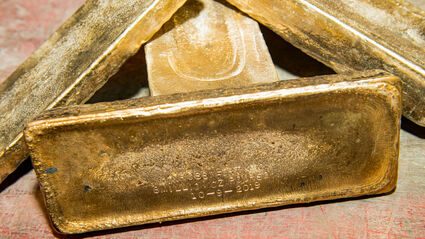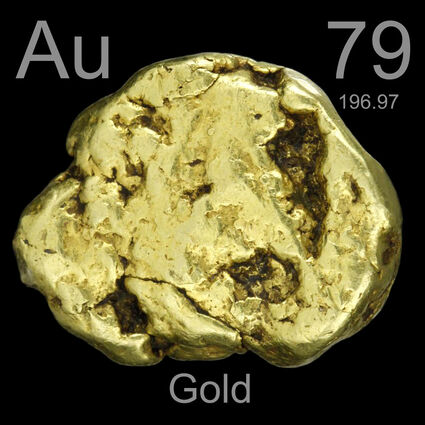Gold – a pathfinder to critical minerals
Six critical metals oft found with placer, lode aurum in Alaska Critical Minerals Alaska 2020 – Published October 29, 2020
Last updated 12/30/2020 at 5:05pm

Kinross Gold Corp.
These bars contain the eight millionth ounce of gold poured at Kinross Gold's Fort Knox Mine. Critical minerals antimony, arsenic, bismuth, tellurium, and tungsten are all associated with this large gold deposit north of Fairbanks, Alaska.
Though gold is not considered a metal critical to the United States, this increasingly valuable precious metal could serve as a pathfinder element for several of the other minerals and metals the U.S. Geological Survey deemed critical to America.
Selling for roughly US$2,000 per ounce and expected to climb much higher as central banks and governments inject unprecedented amounts of cash into a global economy affected by COVID-19, gold has become an increasingly vital safehaven commodity for investors.
"I have zero doubt that gold will go to $2,000, $3,000, $5,000 and possibly much, much further beyond that," Novagold Resources Chairman Thomas Kaplan said earlier this year.
While COVID-19 stimulus is expected to add to gold's relative value, the New York billionaire attributes his bullish gold predictions on basic supply-demand fundamentals. As investors of all classes want more gold as a stable currency, miners are depleting their reserves of the precious metal.
The search for more Alaskan gold to weigh the supply side of the scale could uncover new lodes of the pathfinder minerals and metals considered critical the U.S.
This is because where you find gold in the 49th State you typically find some mix of six of the metals that did make it onto the USGS list – antimony, arsenic, bismuth, tellurium, tin and tungsten.
Most geologists throughout Alaska's relatively short mining history think of this suite of critical minerals as a signature for finding the world-class deposits of gold for which Alaska is renowned.
Reversing this conventional line of thinking, geologists seeking economic deposits of any one of these six critical minerals may want to take a look at the rich deposits of hardrock and placer gold turned up by the explorers that came before them.
Tintina gold pathfinders
While gold has been discovered across Alaska's entire vast landscape, except the oil-rich plains of the North Slope, the Tintina Gold Belt is particularly well endowed with large intrusion-related gold systems and the critical minerals associated with them.
Kinross Gold Corp.'s Fort Knox Mine a few miles north of Fairbanks is a textbook example of the intrusion-related gold systems typical of the Tintina Belt – a 125- by 750-mile gold-rich province that arcs across the middle of Alaska – and the potential to find deposits of critical minerals nearby.
The low-grade but very large gold deposit at Fort Knox has been delivering ore to one of Kinross' most profitable operations since production began there in 1996. So far, this Interior Alaska mine has churned out more than 8 million oz of gold and has enough ore in reserves to keep the mine operating until at least 2030.
When explorers are searching for gold deposits across the Tintina Belt, Fort Knox and the suite of critical pathfinder elements associated with it is often the model.
Bismuth, tellurium, and tungsten are typically found right over the deposit, while arsenic and antimony become more predominant as you get further away.
In 1915, Balkan immigrant Mike Stepovich discovered a high-grade tungsten lode on the flanks of what is now the Fort Knox Mine. His discoveries contributed to America's need for the tough metal during both World Wars and led to further tungsten finds nearby.
Mines around Fort Knox also provided the United States with a domestic supply of antimony during both World Wars.
While these mines have the potential to be a future supply of this semi-metal critical to the economic welfare and security of the United States, the underlying gold is typically more valuable.
Scrafford, a mine that provided a domestic source of antimony during World War I, is one such example.
"The Scrafford antimony deposit is affiliated with an east-west, south-dipping shear zone of the same name that can be followed for at least six miles (10 kilometers)," Barker said.
There are indications that some bismuth was mined in the Salcha River area a few miles east of Fairbanks. In fact, reports of placer bismuth nuggets in Caribou Creek in this area has attracted the interest of gold explorers, considering the critical minerals association to Fort Knox to the west and Pogo to the east.
The same critical pathfinder minerals and metals that led to the discovery of Fort Knox apply to other aurum deposits across the Tintina Gold Belt and beyond.
Cassiterite a coincidence
Many of Alaska's most prolific placer gold producing regions, such as the Circle and Manley Hot Springs districts in Interior, also happen to be rich in tin. This relationship, however, has more to do with climatology than geology.
The most widely known placer tin deposits in Interior Alaska are found along the Tofty tin belt, a 12-mile-long area of tin- and gold-bearing gravels in the Manley Hot Springs district.
"Gold mining in the district developed rapidly, and as the productive area in the vicinity of Tofty increased it was found that tin and gold were generally associated and that the richer concentrations of the two minerals were generally coincident," Henry Eakin wrote in a 1914 report, Tin Mining in Alaska.
At least one stream in the Circle Mining District – Boulder Creek – is also so rich in tin mineral cassiterite that it plugs the recovery plants of placer miners also attempting to recover the gold there.
This gold and tin winding up in the same streams, however, is a coincidence more associated with lack of glaciers erasing the alluvial history than a close relationship in mineralization.
Barker, who investigated the placer tin occurrences at Boulder Creek while with the U.S. Bureau of Mines, said the tin and gold found together there "is more a function of the common erosional and alluvial weathering processes in the absence of major ice sheets."
This lack of major glaciation has contributed to gold, tin, tungsten, niobium, rare earth elements and other critical minerals being found together in placer deposits across Alaska.
"What is unique is the vast extent of old alluvial terrane in the Interior and in eastern Siberia, that have weathered underlying mineralized terranes and sometimes co-mingled the heavy minerals of interest," Barker told Mining News.
This weathering has also completed the initial stages of milling and concentration, giving a would-be placer gold-critical metals miner a head-start over those digging into the hardrock source of these alluvial deposits.











Reader Comments(0)